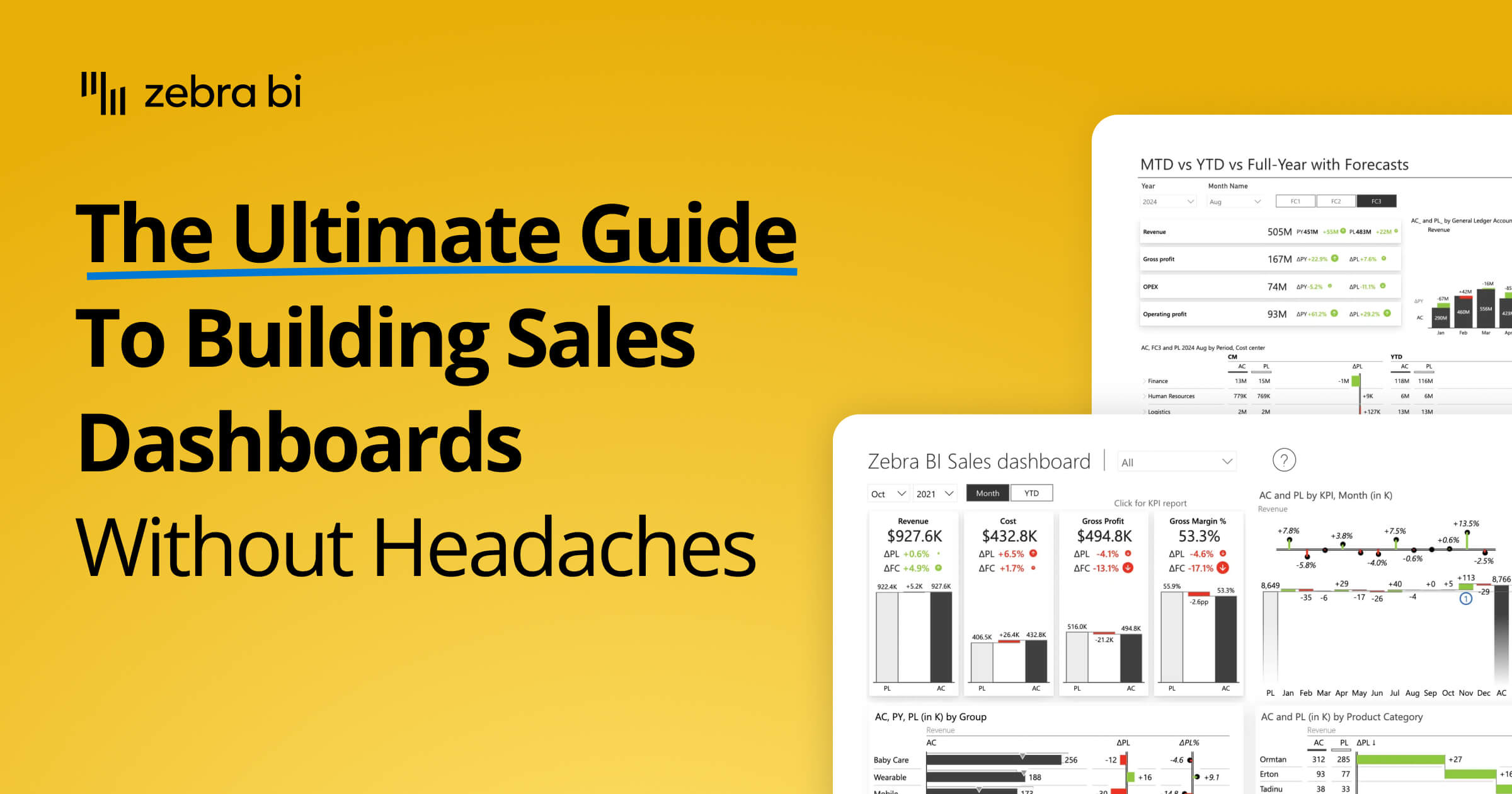
The Ultimate Guide to Power BI Sales Dashboards
PRO Trial
Sales dashboards can be the key to unlocking better sales performance, smarter decision-making, and more effective sales strategies. Many professionals avoid building or improving them. They fear the complexity and technical challenges, especially with tools like Microsoft Power BI.
This guide will take you through everything you need to know to build sales dashboards without headaches. From understanding their purpose to tackling common challenges, we’ll ensure you’re equipped to create and use dashboards that are both effective and user-friendly.
What Is a Sales Dashboard?
A sales dashboard is a visual tool that organizes and displays key sales data. By consolidating metrics like quota attainment, conversion rates, or sales pipeline trends, sales dashboards allow you to monitor business performance at a glance.
Whether you're a sales manager tracking team progress or an executive reviewing revenue figures, dashboards simplify decision-making by spotlighting the most critical information in real-time.
Why Would You Need a Power BI Sales Dashboard?
Power BI is one of the most powerful tools for creating sales dashboards, offering flexibility, advanced customization, and robust analytics features. Here’s how a sales dashboard in Power BI can deliver value across your organization:
1. Real-Time Data
Power BI provides seamless real-time data connections, updating your dashboard as new information flows in. This ensures your team is always working with the most current numbers, reducing manual updates and improving agility.
2. Visual Representation
Dashboards translate raw numbers into intuitive charts, graphs, tables/ matrixes, and maps, turning complex data into clear, visual representations. These visuals don’t just make data easier to process; they bridge the gap for non-technical individuals, allowing anyone to understand patterns, trends, and insights at a glance.
By removing the need for advanced technical knowledge, ready-set Power BI dashboards empower teams across all departments to make informed decisions based on data. Whether it’s identifying sales trends, tracking project progress, or spotting customer behavior changes, visual representations ensure that data is accessible and actionable for everyone.
3. Key Performance Indicators (KPIs)
Tracking KPIs such as monthly sales growth/ customer acquisition, pipeline value, or conversion rates allows teams to measure progress against goals. A good dashboard highlights these figures right where they’re needed.
With clear visibility into these metrics, teams can quickly identify areas that need improvement and take proactive steps to address them.
4. Improved Decision-Making
When stakeholders have access to well-organized, accurate data, they can make faster, more informed strategic decisions.
This not only improves efficiency but also reduces the risks associated with guesswork or incomplete information. Clear data empowers sales teams to identify trends, address challenges proactively, and seize new sales opportunities, all while fostering confidence in the decision-making process.
5. Enhanced Accountability
Sales dashboards not only improve visibility but also empower teams to make data-driven decisions in real time. They highlight sales performance trends, identify areas for improvement, and enable managers to provide timely support or coaching. By offering actionable insights, dashboards help optimize strategies and drive better results across the board.
6. Increased Efficiency
Power BI reports enable you to increase the efficiency of your sales operations. Rather than compiling reports manually, sales dashboards automate data collection and reporting. This frees up valuable time for analysts and managers, allowing them to focus on insights, strategy, and action, rather than crunching numbers.
7. Improved Sales Performance
Seeing metrics like sales trends or bottlenecks in the pipeline empowers teams to take timely action, boosting their overall effectiveness.
8. Better Collaboration
Dashboards act as a single source of truth for sales and marketing, ensuring everyone shares the same insights and priorities.
By centralizing data in one place, dashboards help teams track performance metrics, identify trends, and make more informed decisions. This alignment fosters better collaboration, reduces miscommunication, and keeps both teams focused on achieving common goals.
9. Enhanced Customer Understanding
A Power BI sales dashboard gives you the opportunity to better analyze sales trends, customer segments, and geographic data, thus leading to insights into what drives customer behavior. This can steer both strategy and day-to-day decision-making.
Challenges with Building Power BI Sales Dashboards
Creating an effective sales dashboard in Power BI isn’t without obstacles. Here are some common challenges and how they can trip you up:
- Too Time-Consuming to Build
Building a dashboard, especially for the first time, often takes longer than expected. From creating a relational data model to designing layouts, the process requires patience and attention to detail.
Beyond the technical aspects, there's also the challenge of understanding user needs and ensuring the dashboard delivers actionable insights. Balancing functionality with a clean, intuitive design can be tricky, as it requires constant iteration and testing to get it right--and when things are tricky, they also take time to figure out.
If you want to learn more about building your first reports in Power BI in an easier, hassle-free way, take a look at our webinar, Power BI Made Easy, where our lead BI consultants show you how to create Power BI reports with zero headaches.
- Hard to Explain Variances or Tell a Clear Story
Dashboards full of numbers with no explanation can confuse stakeholders. A lack of storytelling elements—like variance highlights or contextual notes—makes it hard to grasp the “why” behind the data.
To create a meaningful impact, dashboards should go beyond raw numbers and include visual cues, such as color-coded trends, annotations, or brief summaries.
These enhancements provide clarity and help stakeholders quickly identify key insights, empowering them to make informed decisions without having to interpret complex data on their own.
- Lack of Insight
Every report should answer questions like:
- Is your performance good or bad?
- And, if either, by how much?
- What will you or can you do about it?
An aesthetically pleasing dashboard isn’t enough. It might take you through a stakeholder meeting, but when it comes to its impact on the bottom line, it might be insufficient. If your data visualizations fail to answer key questions or link metrics to business outcomes, they won’t drive meaningful action.
- Sluggish Performance with Large Datasets
When datasets are large, dashboards may run slowly or fail to load. Optimizing performance is critical for maintaining usability, and it becomes an even bigger problem in large companies.
Here's more about optimizing the performance of your Power BI dashboards, if you want to learn about this.
- Hard to Personalize for Different Teams or Users
Different teams need different views of the data. Without customization options, a “one-size-fits-all” dashboard may alienate users, or make it really difficult for them to access the data they need for better sales analysis.
- Too Much Technical Work (Especially DAX)
Power BI requires advanced skills like DAX (Data Analysis Expressions) coding for complex measures. This can be a barrier for non-technical users, preventing them from regularly accessing the data (and your entire organization from building and maintaining a data-driven culture).
Types of Sales Dashboards
Not all dashboards are created equal. Your design should reflect your goals and audience. Here are common types of sales dashboards to consider:
1. Sales Funnel Dashboard
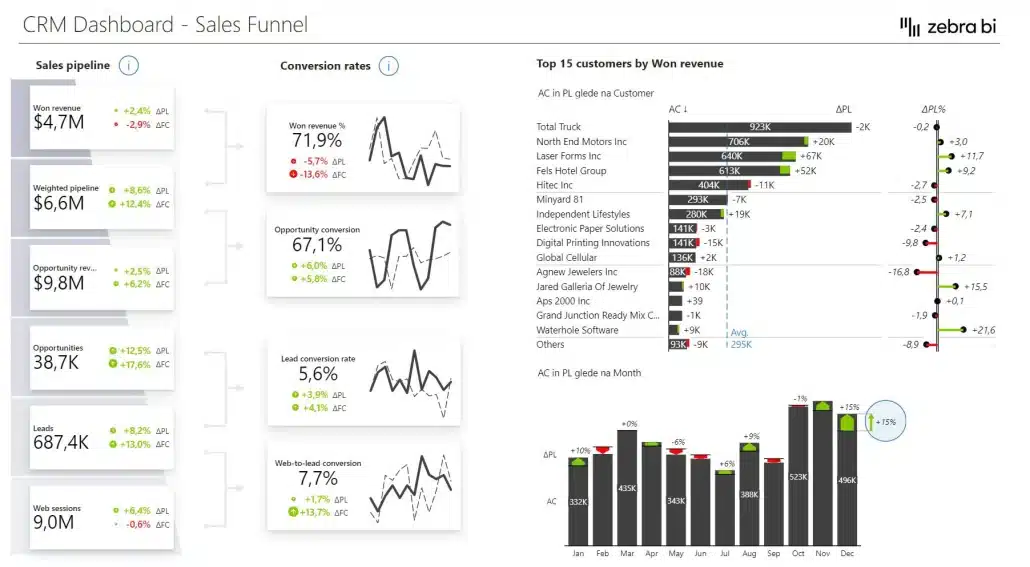
This template provides a visual view of leads moving through the sales funnel. This helps identify where prospects drop off and opportunities for optimization.
Need a Power BI sales funnel dashboard? We have one for you, just click the link and get the free sales funnel dashboard our team of Power BI experts created for you.
2. Sales Dashboard
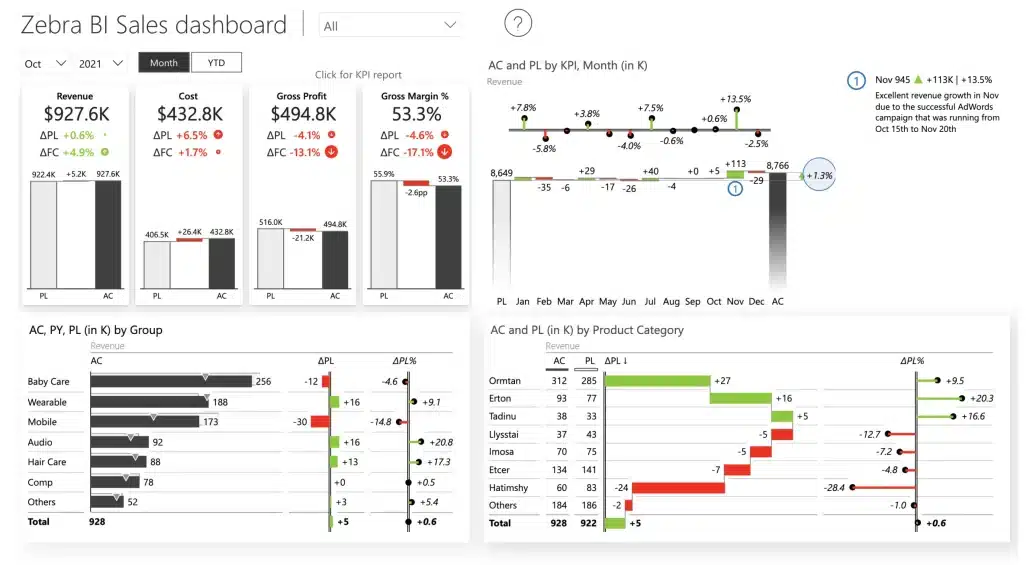
A general Power BI sales dashboard is all-around tool that showcases revenue, sales quotas, and other key metrics in real-time, enabling sales and marketing teams to better align and drive better business intelligence.
Here's a free Power BI sales dashboard if you want to save days of work.
3. SaaS Metrics Dashboards
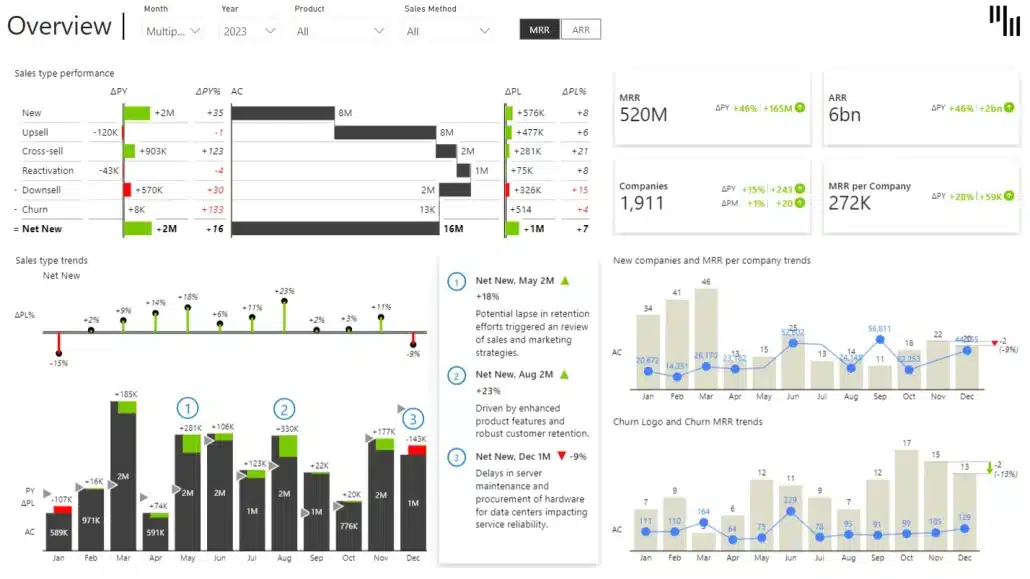
Designed for Software as a Service (subscription-based) businesses, this dashboard template highlights SaaS metrics like Upsells, Cross-sells, Reactivations, Downsells, and Churn.
Want a quick way to implement a Power BI SaaS sales dashboard? Grab the one we created for you, for free.
4. Forecast vs. Actual
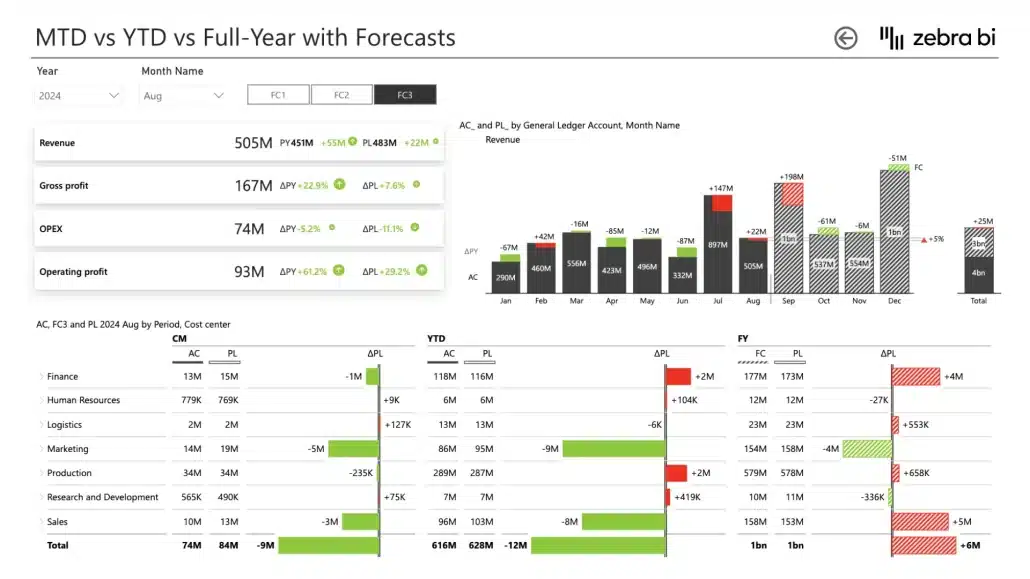
A Forecast vs Actual Power BI dashboard compares projected sales versus actual business performance, revealing discrepancies and aiding future forecasts. This helps businesses identify trends, adjust strategies, and improve the accuracy of future sales predictions.
5. Territory/Regional Power BI Sales Performance Dashboard
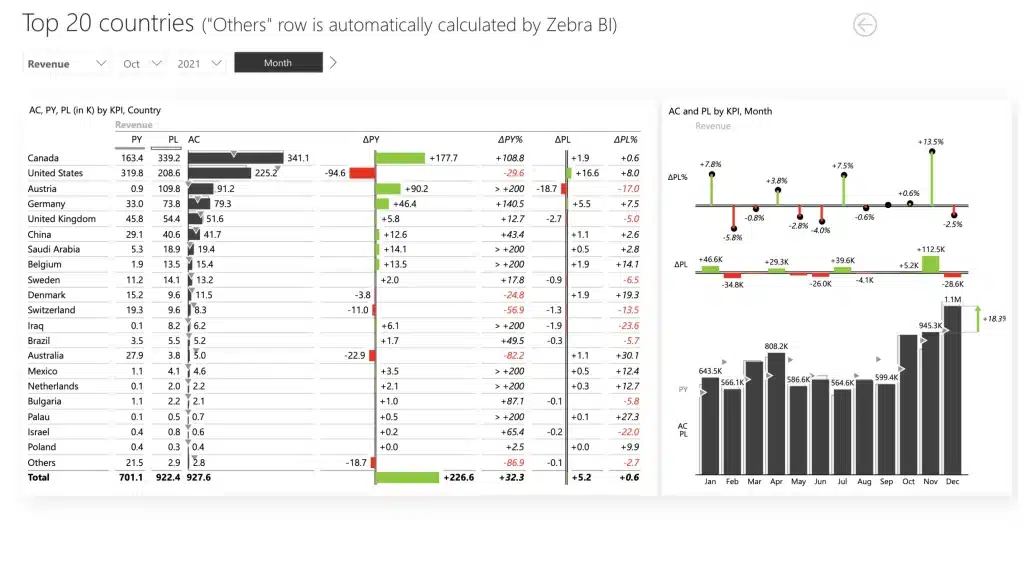
This type of Power BI dashboard analyzes metrics across different territories or regions to pinpoint high-performing areas or those needing support. This helps organizations allocate resources effectively and develop targeted strategies to improve performance where it’s needed most..
6. Sales Rep/Team Performance
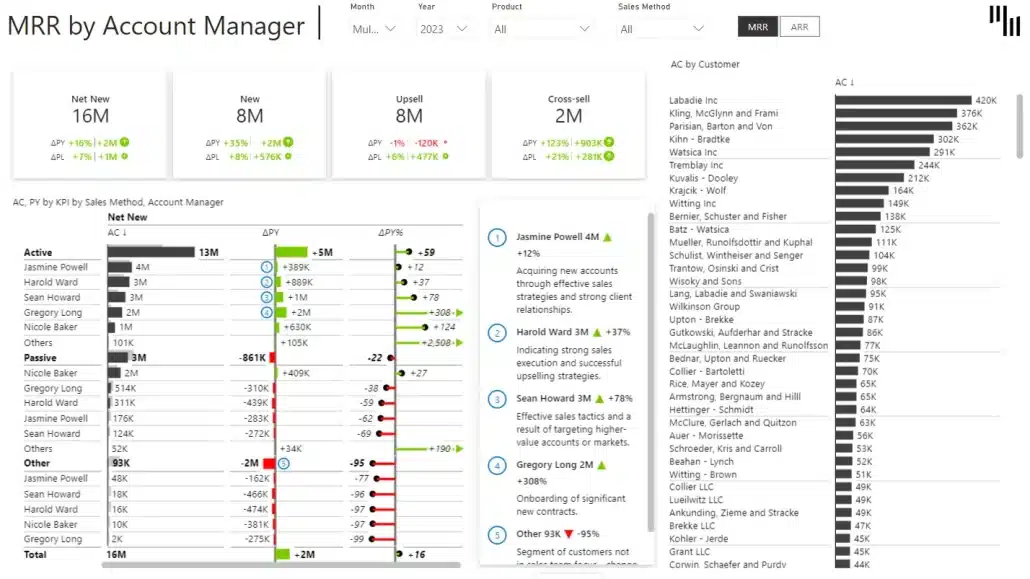
A sales rep dashboard breaks down performance by individual reps or teams, highlighting top performers or areas for improvement. This helps managers make data-driven decisions to boost overall productivity and address specific challenges.
7. Sales and Marketing Alignment

A Marketing & Sales alignment Power BI brings together sales and marketing metrics, such as lead-to-opportunity conversion rates or campaign attribution data. This helps marketing and sales teams better coordinate and take better decisions for the business.
Key Components of a Good Sales Dashboard
A well-designed sales dashboard shares these core features:
1. Interactive Visuals (Click, Drill, Slice)
Interactive elements like drill-throughs, slicers, and filters allow users to explore data from multiple perspectives. These tools empower users to customize their sales analysis, uncover deeper insights, and focus on the specific information most relevant to their needs.
Responsive Layout for Different Users
Ensure the design adapts to multiple devices and user roles, whether viewed on desktop, tablet, or mobile. This ensures a seamless and consistent user experience regardless of the platform or screen size.
3. Performance-Optimized Visuals
Use clean, minimal designs to keep dashboards fast and responsive, even with large datasets. This ensures users can quickly access and analyze data without unnecessary delays or visual clutter..
Want to consolidate your visuals and embrace and integrated approach to creating reports? Here's how to speed up your reports and visuals, easily.
4. Real-Time Data Connections
Reliable connections to live data sources ensure the dashboard reflects up-to-the-minute changes. This allows users to make informed decisions based on the most current and accurate information available.
5. Storytelling Features (Titles, Comments, Variance Highlights)
Add context to your visuals with titles, highlights, or comment sections that explain shifts or anomalies. This helps viewers quickly grasp key insights and understand the story behind the data.
Additionally, other Power BI features, like tooltips, bookmarks, cross-visual filtering, formulae editors, quick calculations, or expanding/ collapsing hierarchies can all help you tell a full story (as opposed to just presenting some numbers in a dashboard).
Sales Dashboard Metrics You Should Consider Including
To build a dashboard that’s both functional and comprehensive, consider these metrics:
- Quota Attainment: Measures the percentage of a salesperson's target achieved. It shows how well sales teams meet their goals.
- Conversion Rate: Tracks the percentage of leads turning into customers. Higher rates indicate effective sales strategies.
- Average Deal Size: Calculates the average revenue per sale. It helps evaluate sales value and potential business growth.
- Sales Cycle Length: Evaluates the duration required to finalize a deal. Typically, shorter sales cycles indicate more streamlined and efficient processes within a sales team.
- Customer Churn Rate: Tracks the percentage of customers lost over a period. Lower churn means higher customer retention. Combined with other customer KPIs, like customer acquisition cost, customer lifetime value, and so on, the churn rate can provide you with a good assessment of not just your sales reports, but also insights about product performance and the effectiveness of your marketing campaigns.
- Total Sales: Displays the total income produced during a defined period, providing a vital indication of the company's overall financial health and operational effectiveness.
- Sales by Region: Analyzes and presents revenue data segmented by geographic regions. It identifies and underscores which particular areas are showing the highest performance.
- Sales by Product/Category: Monitors the sales performance of particular products or categories. This aids in recognizing which items are performing the best.
- Sales Trends: Examines trends in sales data across different periods, to help you improve overall business performance. This analysis aids in predicting future sales outcomes and refining business strategies.
- Sales Pipeline: A sales pipeline dashboard is a data visualization of the stages of potential deals. A healthy pipeline ensures steady revenue growth.
- Customer Segmentation: Clusters customers according to shared characteristics. This segmentation enhances both targeting efforts and personalization strategies.
- Profitability: This metric represents the remaining revenue after all associated costs and expenses have been deducted. When profitability is high, it usually signifies that operations are being managed in a highly efficient manner.
What Makes the Best Sales Dashboards in Power BI
Great dashboards don’t happen by accident. Follow these principles:
1. Understanding Your Audience
Know who will use the dashboard and what insights they need most. Understanding your audience ensures the dashboard is tailored to their specific goals and requirements. This approach helps present data in a clear, actionable way, making it easier for users to make informed decisions..
2. Carefully Choosing Your Goals & KPIs
Link your dashboard design to specific objectives and measurable KPIs. This ensures your dashboard provides clear, actionable insights that align with your goals. By focusing on relevant metrics, you can track progress effectively and make data-driven decisions with confidence..
3. Connecting Dashboard to Live Data Source
A live data connection makes the dashboard adaptable and relevant. It ensures that the information displayed is always up-to-date, reflecting real-time changes and insights. This allows users to make informed decisions quickly, without relying on outdated or static data..
Make Your Dashboard Actionable, Collaborative, and Visual
With the right tools by your side (like Zebra BI), it's easy to turn a simple Power BI dashboard into an actionable source of insights for the entire team. In our webinar, Power BI made easy, our lead BI specialists did a quick run-through the main steps you need to take to make this happen:
- Cleaning your data
- Implementing a (star schema) data model
- Implementing reporting best practices (like choosing the right charts, displaying the variances, using consistent colors, labels and shapes, identifying scenarios by fill patterns, and so on)
- Implementing advanced visualizations (like cards for top level KPIs, tables for structural analysis and financials, or charts for time series).
- Supporting adoption and collaboration across the team to ensure everyone has access to the same source of truth, centralized feedback, improved productivity, and reduced likelihood of misunderstandings.
If you want to know more about the above and how to use Power BI and Zebra BI together, watch the aforementioned webinar for free.
How to Create a Sales Dashboard in Power BI
Here’s a step-by-step breakdown for creating a Power BI sales dashboard:
1. Connect Your Data
Integrate data sources like CRM, ERP, or marketing tools into Power BI to bring all your important information into one place. Use built-in connectors for a seamless setup.
2. Transform & Model Your Data
Clean your data by removing duplicates or errors, and structure it with relationships and calculations to ensure it’s accurate and actionable.
3. Create Visualizations
Choose visuals like bar graphs, line charts, or heatmaps to create data visualizations that present sales data clearly. Tailor them to highlight insights that align with your business objectives.
4. Add Filters and Slicers
Set up filters and slicers so users can drill down into specific details like regions or product types, making dashboards interactive and insightful.
5. Publish and Share
Publish your dashboard to Power BI and provide access to stakeholders so they can view, interact, and make decisions based on the data in real time.
Conclusion
Creating effective sales dashboards doesn’t have to be a headache.
Good tools (like Zebra BI), some solid templates, and just a bit of time for the set-up are all you need.
Start small, get clear on your metrics, and revisit dashboards regularly to ensure they evolve with your business. Most importantly, focus on driving action—not just showing data. With these tips and Power BI’s powerful capabilities, you’ll soon have dashboards that empower smarter, faster decisions across your sales organization.
Want to give Zebra BI a try?
What is a Power BI sales dashboard?
A Power BI sales dashboard is an interactive report that consolidates key sales metrics—such as revenue, pipeline, win rates, and churn—into one place. It allows sales teams, RevOps, and executives to track performance in real time and make data-driven decisions.
Why should I use Power BI for sales dashboards instead of Excel or CRM reports?
While Excel and CRM systems (like Salesforce or Dynamics) provide raw data, Power BI transforms that data into dynamic, visual dashboards. With Zebra BI visuals, you can add variances, trend analysis, and small multiples that CRM reports don’t support—making it much easier to identify patterns and act on them.
What KPIs should a Power BI sales dashboard include?
Typical KPIs in Zebra BI sales dashboards include:
- Revenue (by product, region, or rep)
- Pipeline coverage and forecast accuracy
- Win rate and average deal size
- Sales cycle length
- Churn and retention (for SaaS and subscription businesses)
- Variance vs. budget/target
The exact mix depends on your business model, but our examples cover both transactional and recurring-revenue sales models.
How do Zebra BI visuals improve sales dashboards in Power BI?
Native Power BI visuals often lack advanced sales reporting features. Zebra BI adds:
- Automatic variance analysis (vs. target, budget, forecast)
- Small multiples to compare sales by region, rep, or product
- Top N + Others logic to keep dashboards clear
- Dynamic comments for collaboration inside reports
- IBCS®-certified design for executive-ready reporting
This ensures your dashboards highlight why numbers are changing, not just what they are.
Can I connect my CRM data directly to a Power BI sales dashboard?
Yes. Power BI connects to most major CRMs (Salesforce, HubSpot, Microsoft Dynamics, etc.) as well as SQL databases and Excel files. Once connected, you can apply Zebra BI visuals to transform the raw CRM data into clear, interactive dashboards.
What types of sales dashboards can I build in Power BI?
With Zebra BI, you can build fully interactive and business-ready sales dashboards, including:
- Sales Dashboard in Power BI – A comprehensive view of revenue, targets, variances, and trends to give executives and managers a clear performance snapshot.
- Sales Funnel Dashboard in Power BI – A detailed look at pipeline coverage, stage conversion, and deal progression to help sales and RevOps teams optimize their funnel.
- SaaS Sales Dashboard in Power BI – Tailored for subscription businesses, with metrics like MRR, ARR, churn, and expansion revenue to track growth and retention.
Our free templates make it easy to get started.
Do I need advanced DAX skills to build Power BI sales dashboards?
Not with Zebra BI. Complex calculations like variances, subtotals, or Top N breakdowns are automated. This means sales ops or finance teams can build dashboards quickly, while BI analysts can still extend functionality with custom measures if needed.
How can Power BI sales dashboards help SaaS companies in particular?
SaaS sales teams need to track recurring revenue metrics like MRR, ARR, churn, and expansion. Zebra BI’s Power BI sales dashboards handle these KPIs out of the box, enabling subscription businesses to monitor customer health and forecast revenue with greater accuracy.
Can I share Power BI sales dashboards with my sales team and executives?
Yes. Power BI dashboards built with Zebra BI visuals can be published to Power BI Service or embedded in Teams, SharePoint, or apps. They are fully interactive, mobile-friendly, and can be tailored for different audiences (executives vs. sales reps).
How do I get started with Power BI sales dashboards?
You can:
- Download one of free Zebra BI sales dashboard templates.
- Start a free trial of Zebra BI for Power BI.
- Prepare the report to fit to your data needs with your new Zebra BI visuals.